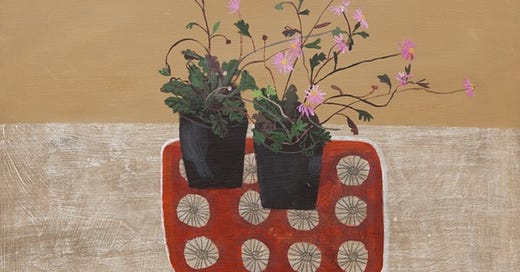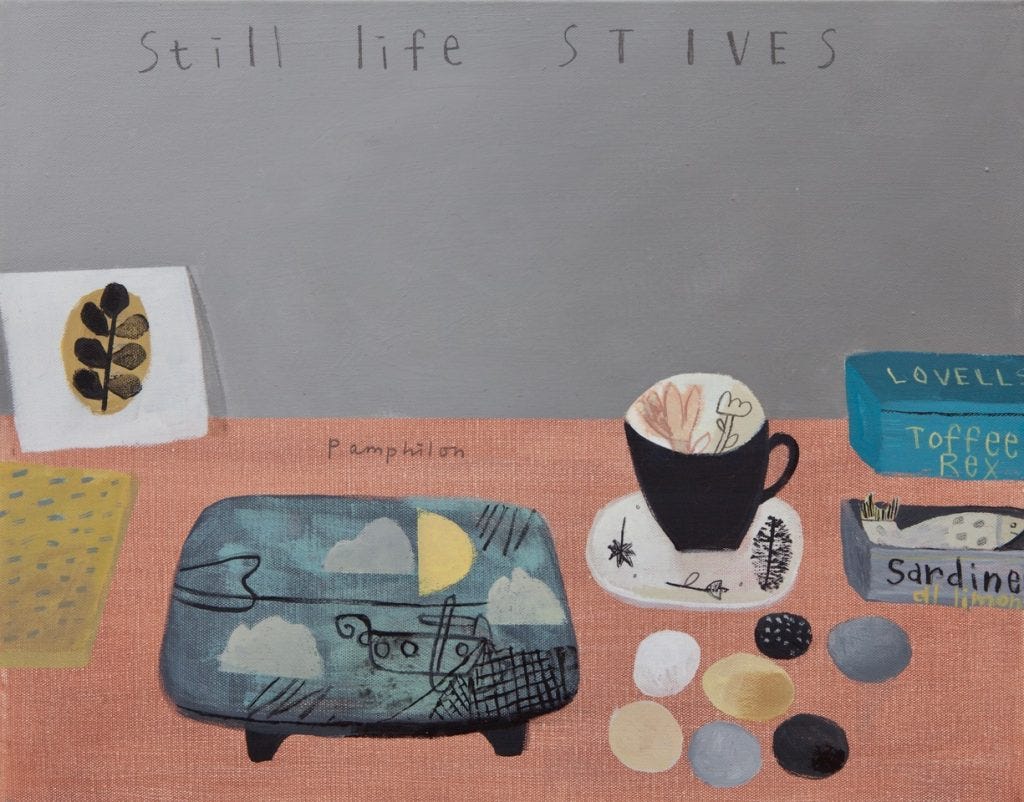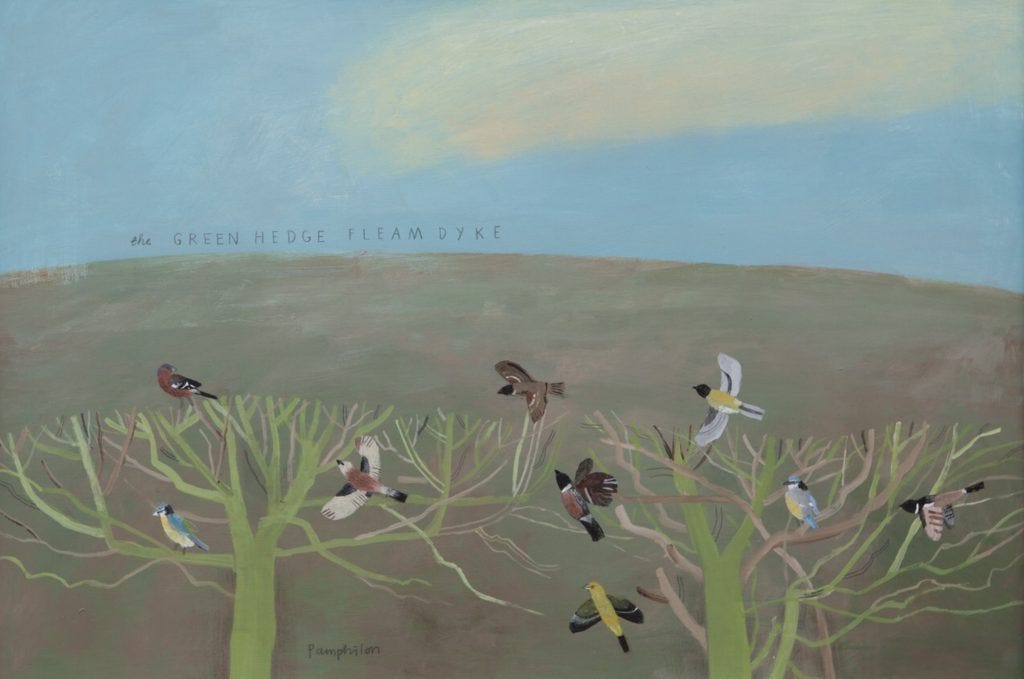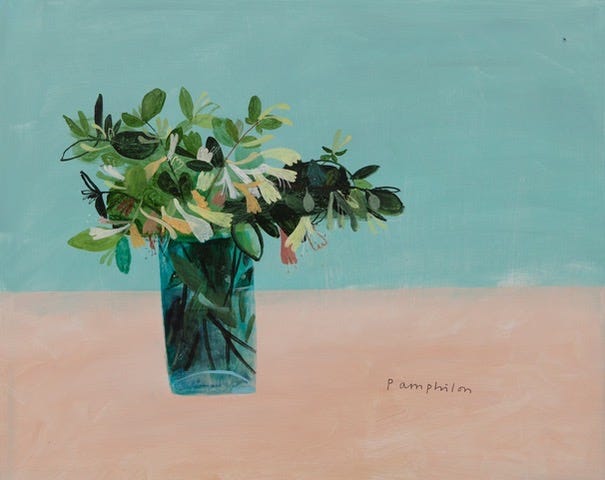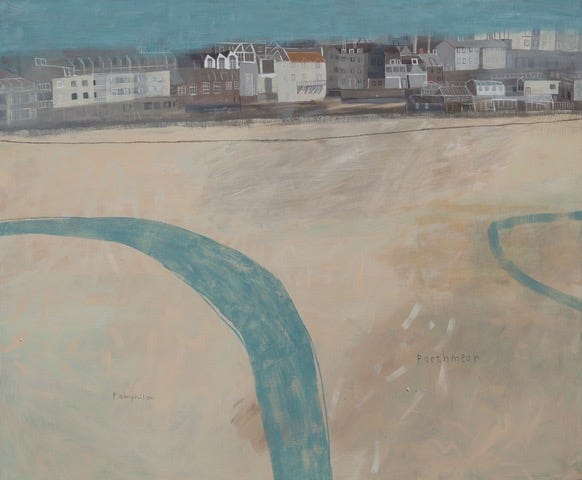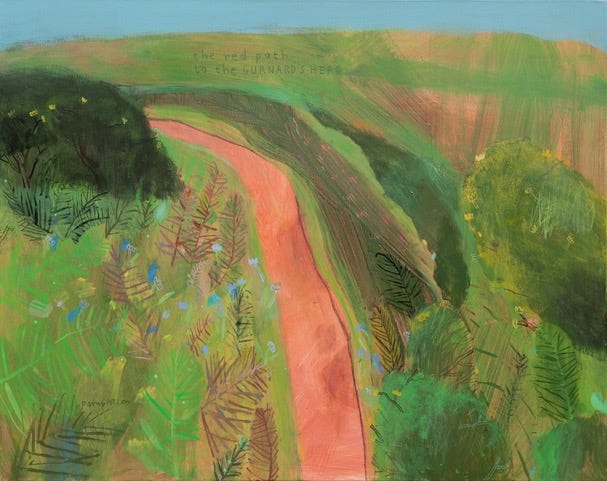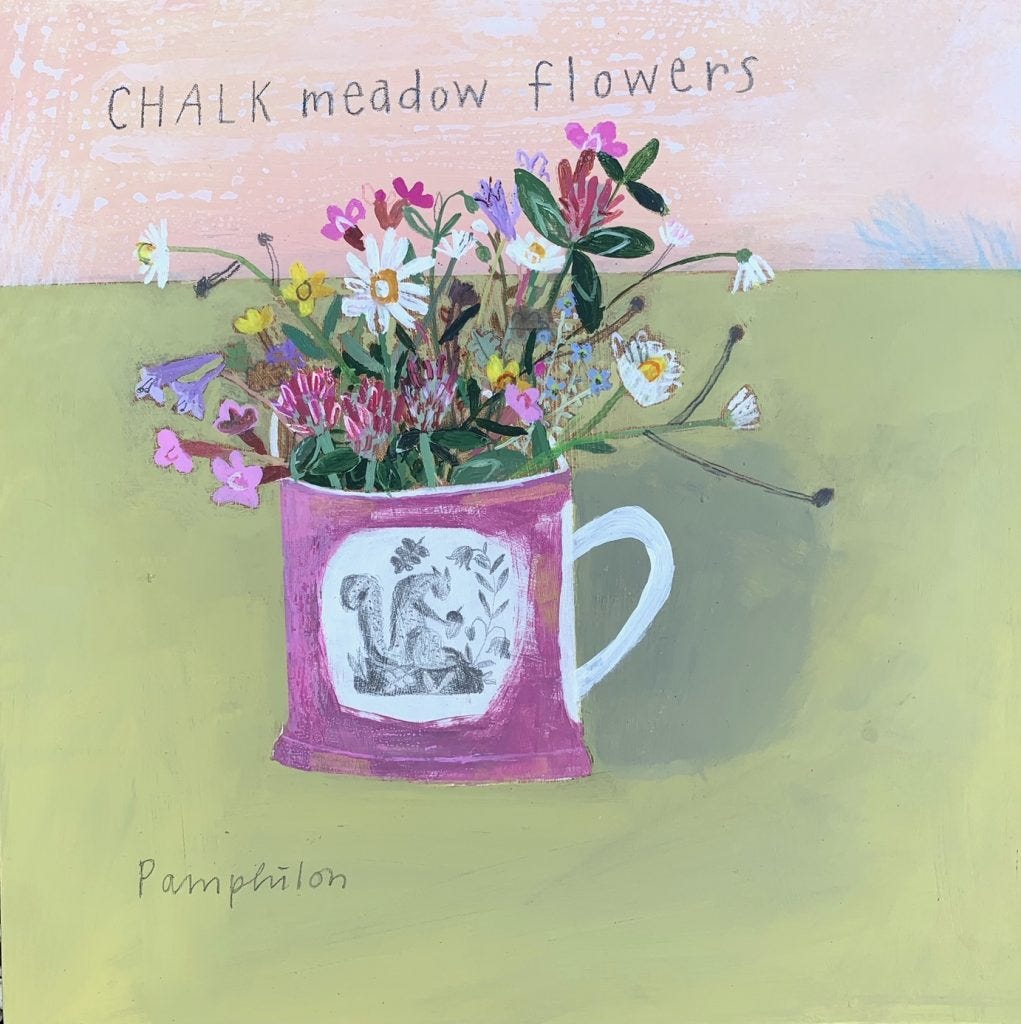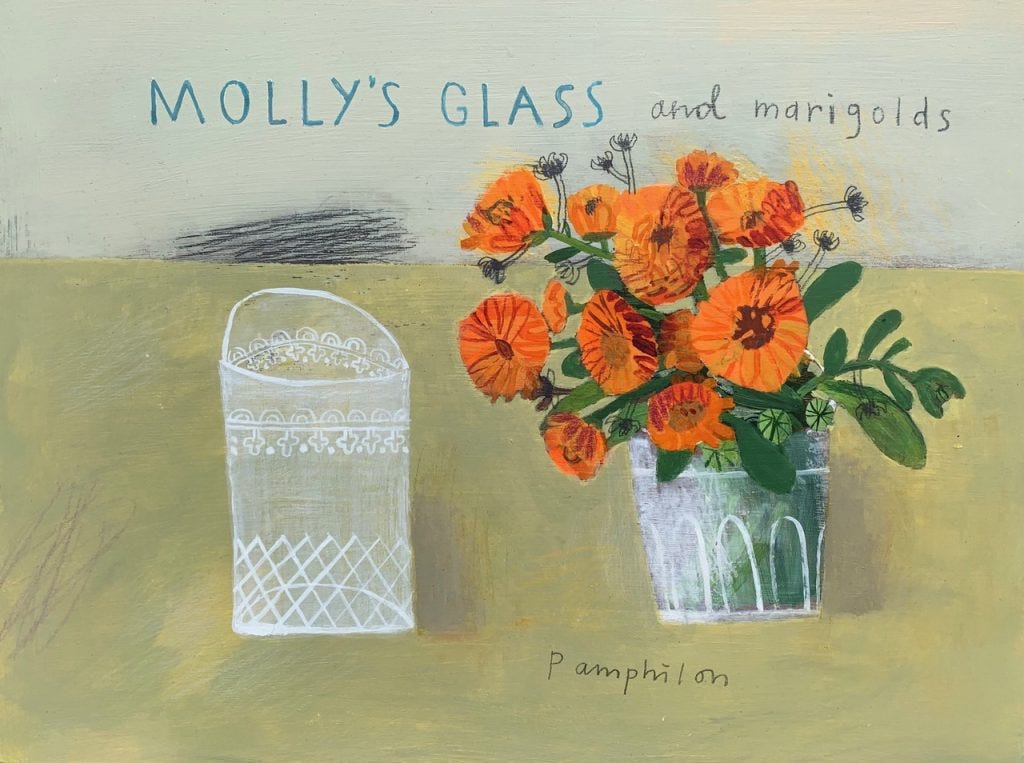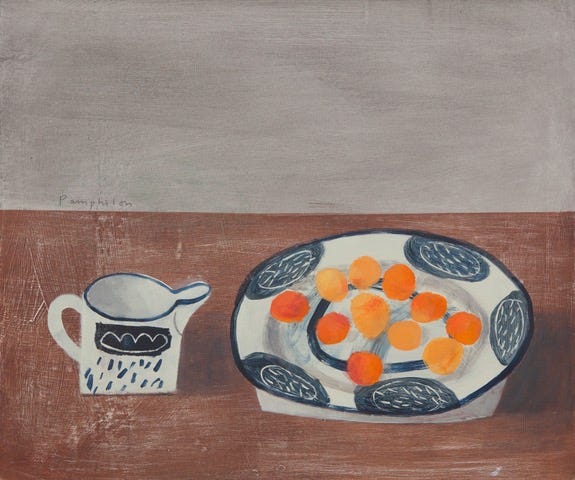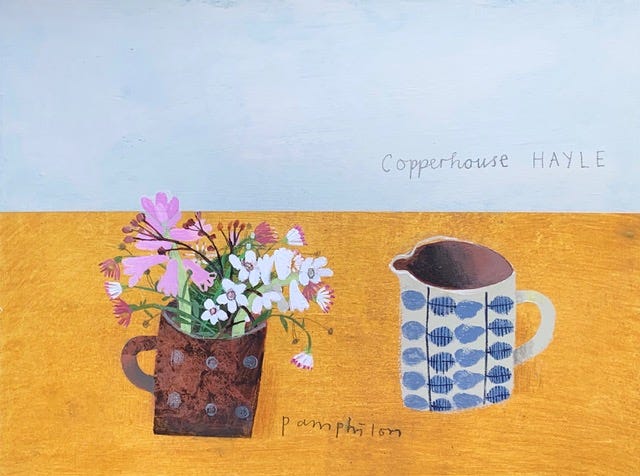Recently, I’ve noticed that many people get a “deer in the headlights” look when I ask them to tell me what they love…what they feel passionate about…what makes them tick. Not so the artist that I’m celebrating today as part of my 100 Days of Encouragement Project.
Elaine Pamphilon, is a British painter who absolutely knows what she loves — and many things are on the list — fields, paths, china tableware, color (always color), sheds, shelves, patterns, people, pebbles, quotes, travel (with the requisite souvenirs), and windowsills, to name just a few. These fascinations fuel her quiet paintings, and she’s happy to revisit these subjects again and again, always gleaning something new from each encounter.
Her painting style has been described as naïve and graphic because items are painted without much attempt to create illusory space. What appears as simplicity is actually full of exquisite decision-making, careful attunement, and a well-honed spirit of wonder. She observes that making paintings look simple and spontaneous is actually quite challenging, but it’s the joy of her practice to communicate more with less.
Elaine was raised in a family of musicians. Her father was a violinist with the London Symphony Orchestra, and her mother taught violin and piano, directed the church choir, and organized community plays and village pantomimes. Her brother was a chorister at Westminster Abbey.
Following in these musical footsteps, Elaine received a scholarship to train at the Royal Academy in harp and piano at age 10. Leaving school early, she went to Paris to study the harp. While there, she also worked as an au pair for the French painter Andre Hambourg. In his large studio in Montparnasse, Elaine was smitten with the stacks of canvases and the smell of oil paints.
When she returned to London, she received a year-long full-time scholarship to the Royal Academy, and eventually studied art and music at Homerton College, Cambridge. Her art tutor, Kay Melzi, had studied under renowned British printmaker and educator, Michael Rothenstein. You can see the delicate trails of this emphasis on design in Elaine’s work today.
What followed was a rewarding and rich season of performing with soloists and conductors in operas, chamber music, recitals, recordings, and filmed productions with choirs at Clare College and Kings College. She even played the harp in a film about the life of Isadora Duncan, whose lover Isaac Singer (of sewing machine fame) had hired a harpist to play all night long for Isadora’s dancing pleasure.
However, when Elaine’s first husband, John, died from leukemia at age 33 and she found herself raising three small children as a single mother, she needed to re-evaluate her professional life to find something that better accommodated the needs of her family.
In 1989, she met and married sculptor Christopher Marvell. He suggested that she turn her creative energies to painting. And she did! Having already studied art, it wasn’t much of a leap, but she was bolstered in her pursuits by the fact that she trusted him to be a frank and fair evaluator of her work.
You can sense the synergy of her musical and painterly passions when you look at Elaine’s artwork. There is a lyricism, a sense of phrasing and rhythm, that adds a measure of atmosphere to her often sparse works. One of her favorite quotes expresses the complementary nature of her passion for music and painting beautifully:
“Colour is magical like a chord struck on a harp in the darkness” — Alan Davie
Both her style and her mediums of choice (water-based paints, such as watercolors, gouache, and acrylics) were initially issues of practicality rather than an over-arching artistic philosophy. Squeezing painting time into the schedule of her busy young family drove her to find materials that dried fast and cleaned up easily and a style that was not overly complicated.
Today, she and Christopher split their time between their home and studio in Cambridgeshire and their Cornish cottage in St. Ives. No matter which residence they are occupying, daily walks are an important part of their routine. They love to soak up inspiration from the sights and sounds around them, as well as talk together about life and art (mostly art). Elaine carries a sketchbook to note the lines of a path or the shape of a curve of land that may later find their way into her paintings. This careful noticing helps her to recall the colors and sensations of her daily experience.
But as much as walking is a part of her creative routine, Elaine also embraces stillness. She likes to sit in front of her window and observe the view, or pick up treasures from her shelves or ledges and really gaze in wonder at the shapes and colors, or sit on her front stoop in Cornwall and delight at the way light dances on the surface of the sea. Rather than becoming dulled by the ubiquitous, familiarity is actually a doorway to discovery for her.
“If you are inspired by life it dictates what you make….feel your way into a painting and your life is enriched.” — from Elaine’s artist statement
The link between Cambridgeshire and Cornwall is also a rich one for Elaine. She knew the late “Jim” Ede, art collector and former director of the Tate. In 1956, he began converting four 19th century cottages in Cambridge into Kettle Yard, his home and gallery space for his collection of British painters, such a Winifred Nicholson, Alfred Wallis, Ben Nicholson, Christopher Wood, and Barbara Hepworth. Now Cambridge University’s gallery of modern and contemporary art, Kettle Yard continues to be a source of inspiration for Elaine. The stories that Ede shared with Elaine about Wallis and the other artists who drew inspiration from the Cornish coast in the 40s and 50s, encouraged the Pamphilon-Marvel family to take a second residence in St. Ives.
I can see some of the color sensitivity and and simplicity of form of Winifred Nicholson in Elaine’s work. Her paintings shimmer with a similar emotional resonance and connection to the natural world. And, like Winnifred, Elaine knows the power of artistic partnership for inspiration and growth.
Elaine enjoys adding words to her artwork. There is something about the use of lettering in her work that evades being obvious or trite. The words seem personal and invitational. We may not know who Molly is, but when we see Elaine’s painting of Molly’s glass and Marigolds, the very assumption that we would know seems to draw us in, as if we’ve been given an “insider’s pass” into the artist’s life. This gesture of familiarity crosses the emotional divide, creating a bridge for us to journey into a shared space and vision.
And with her words, she also joins the dream and mystery and magic behind everyday objects to the painted views and labels, perhaps evoking Magritte’s famous Treachery of Images (“this is not a pipe”) painting.
I am drawn to Elaine’s painted worlds. I feel as if they simultaneously invite me to share her memories and revisit my own.
Her view of wildflowers and grasses in a favorite lustreware mug has the power to evoke the scents of clover and buttercups and climbing roses that I used to pick for my mom (anything of the non-weed variety mostly pilfered from neighbor’s gardens). I would plunk my “treasures” into one of her “fancy” china cups, and endlessly ask her to admire the results.
That sense of the immediacy of things freshly picked and the timeless bid to be recognized as beautiful combine with sweet, achy nostalgia as I look at Elaine’s work. And this combination is utterly compelling for me.
How You Can Be an Encouragement
Please check out Elaine’s offerings on Instagram, follow her, and send her some encouragement today by commenting on one of her posts or sending her a direct message.
Instagram: @elainepamphilon
Website: www.elainepamphilon.com

